Key takeaways:
- Git rebasing creates a cleaner, more linear commit history, improving collaboration and project understanding.
- Rebasing is beneficial during feature development and for organizing multiple smaller commits into a single clear commit.
- Effective communication and reviewing commit history are crucial to avoid sync issues and conflicts during rebasing.
- Practicing rebasing in smaller chunks and conducting dry runs can enhance confidence and reduce complications.
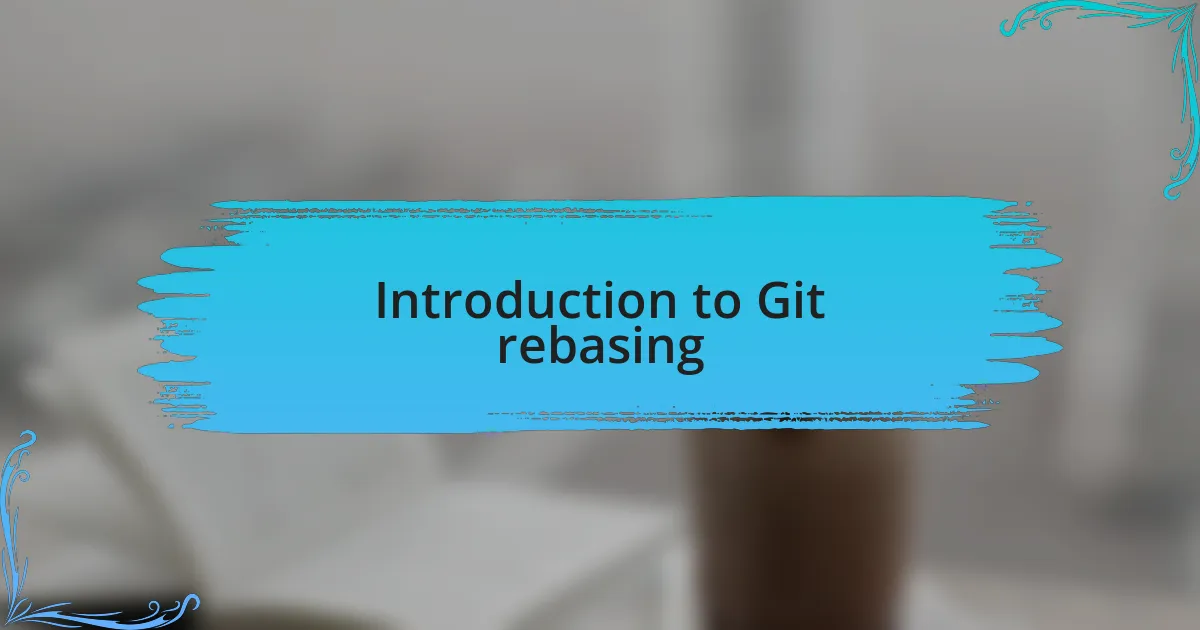
Introduction to Git rebasing
Git rebasing is a powerful technique that allows developers to create a linear project history by reapplying commits from one branch onto another. I remember the first time I attempted rebasing; it felt like walking a tightrope without a safety net. The potential for cleaner commit history was enticing, but the fear of messing things up was daunting.
While working on a feature branch, I discovered how rebasing could simplify my workflow. Instead of merging, which often left a messy trail of commits, rebasing let me take my changes and apply them directly on top of the main branch’s latest version. Have you ever faced a situation where your commit history felt cluttered? This is when I realized the importance of keeping things neat and tidy, allowing for easier collaboration and understanding of the project.
I often encourage fellow developers to embrace rebasing for its ability to streamline collaboration. When you’re working with a team, messy histories can be confusing. Isn’t it better to have a clean, understandable history that tells a straightforward story of how your project evolved? Adopting this practice not only enhances your own workflow but also contributes positively to the entire team’s experience.
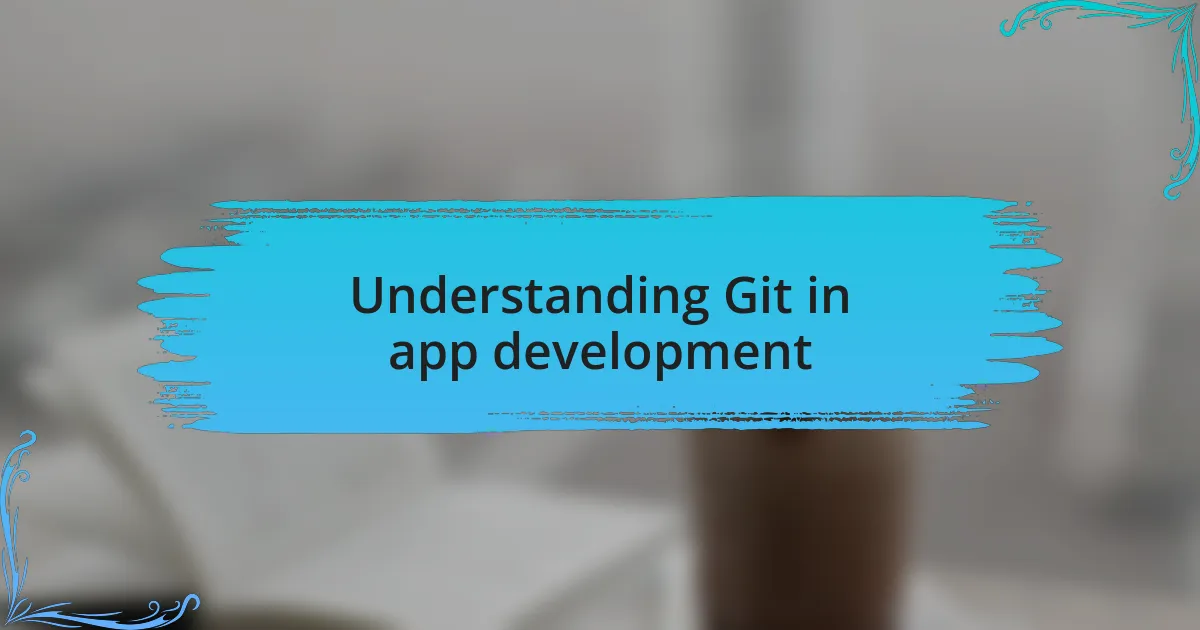
Understanding Git in app development
Git is more than just a version control system; it’s the backbone of collaboration in app development. I remember the first time I introduced Git to a team unsure of how it worked. Watching them realize they could track changes and revert to previous versions was a game changer. Have you ever faced the dread of losing crucial work? With Git, I found a safety net that allows us to experiment confidently without that fear.
Understanding branching and merging in Git felt like unlocking a new skill set for me. Early on, I would often get lost in the maze of branches, leading to conflicts that felt insurmountable. However, over time, I learned to embrace the concept of creating specific branches for features or bug fixes. It’s empowering to know you can merge changes at any point while keeping the main branch stable. Isn’t it thrilling to know your codebase is safe while you innovate?
When I think about the importance of commit messages, it’s hard not to smile at the memories of my early confusion. I used to write vague messages like “fixed stuff,” which now make me chuckle. Now, I approach each commit with a story in mind, thinking about future collaborators who will read it. Clear commit messages provide context, and I genuinely believe they’re a key to maintaining an efficient workflow. How does your commit history look?
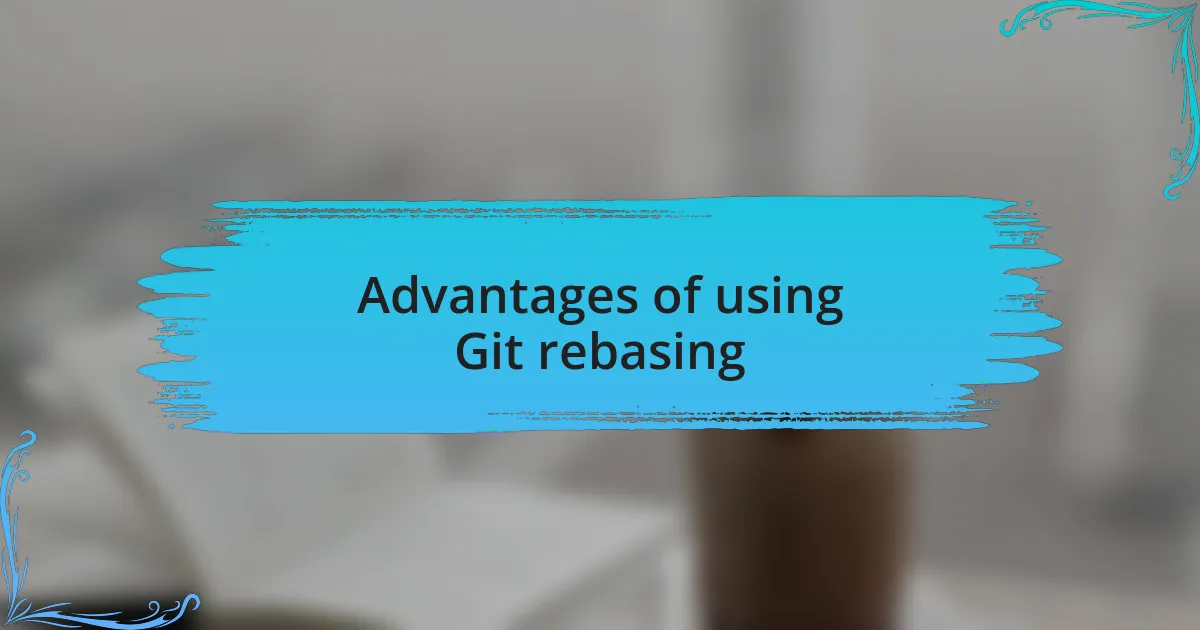
Advantages of using Git rebasing
One significant advantage of using Git rebasing is the cleaner project history it creates. When I first encountered rebasing, I was astonished at how it transformed a cluttered commit history into a more linear progression. Have you ever grappled with a project log filled with messy merges? For me, it was like breathing fresh air when I switched from merging to rebasing; suddenly, my team’s contributions flowed like a cohesive story rather than a jumbled mess.
Another aspect that stands out is how rebasing simplifies the process of integrating changes. In my experience, rebasing allows me to place my changes on top of the latest version of the codebase seamlessly. This not only reduces the chances of conflicts but also helps me resolve issues as I go. It’s a fantastic way to maintain a smooth workflow—who doesn’t appreciate fewer interruptions during development?
Lastly, I find that rebasing fosters a deeper understanding of the codebase. When I rebase, I often take the time to digest the changes made by others in the team, which enhances my awareness of the overall project. Isn’t it interesting how a simple technique like rebasing can strengthen collaboration and knowledge-sharing? Each time I do it, I feel more connected to the work of my teammates, and it inspires better cooperation moving forward.
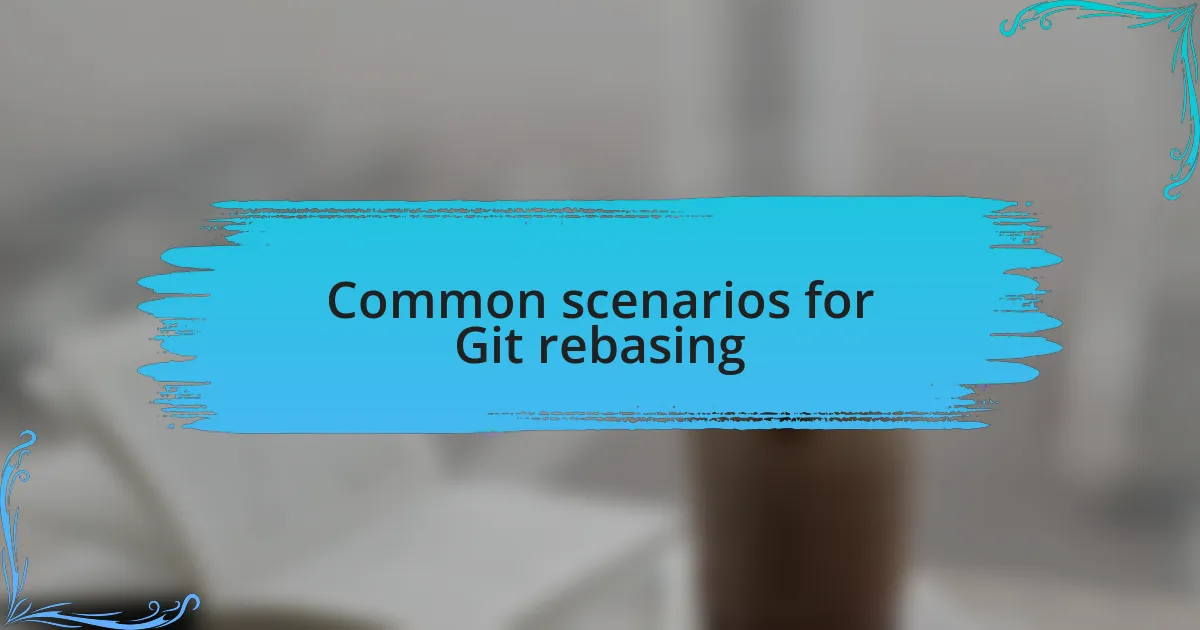
Common scenarios for Git rebasing
When it comes to developing features in parallel, one common scenario for using Git rebasing is during feature branch updates. I distinctly remember working on a new functionality while my teammate simultaneously fixed a critical bug. By using rebasing, I was able to pull the latest changes from the main branch right into my feature branch. This process ensured I was working with the most up-to-date code, which minimized the risk of stumbling into conflicts later on. Have you ever felt the weight of merging a feature only to find it’s outdated?
Another prevalent scenario is when incorporating numerous smaller commits into a clean, single commit before merging. I recall a time when I had a series of trial-and-error commits while perfecting a specific feature. By rebasing, I could squash those multiple commits into one clear commit that conveyed the entire thought process succinctly. It not only made my contribution neater but also allowed others to understand the evolution of my work at a glance. Isn’t it satisfying to have a concise commit history that tells a cohesive story?
Lastly, rebasing shines brightly in situations where maintaining an organized workflow amidst a busy team is crucial. I once participated in a collaborative project where every team member worked on various aspects of the software simultaneously. During our sprint reviews, using rebasing kept our commit history streamlined, allowing us to focus on discussing the project direction rather than getting sidetracked by historical commit conflicts. Have you experienced the joy of an orderly process that allows your team to keep its eyes on the goal?
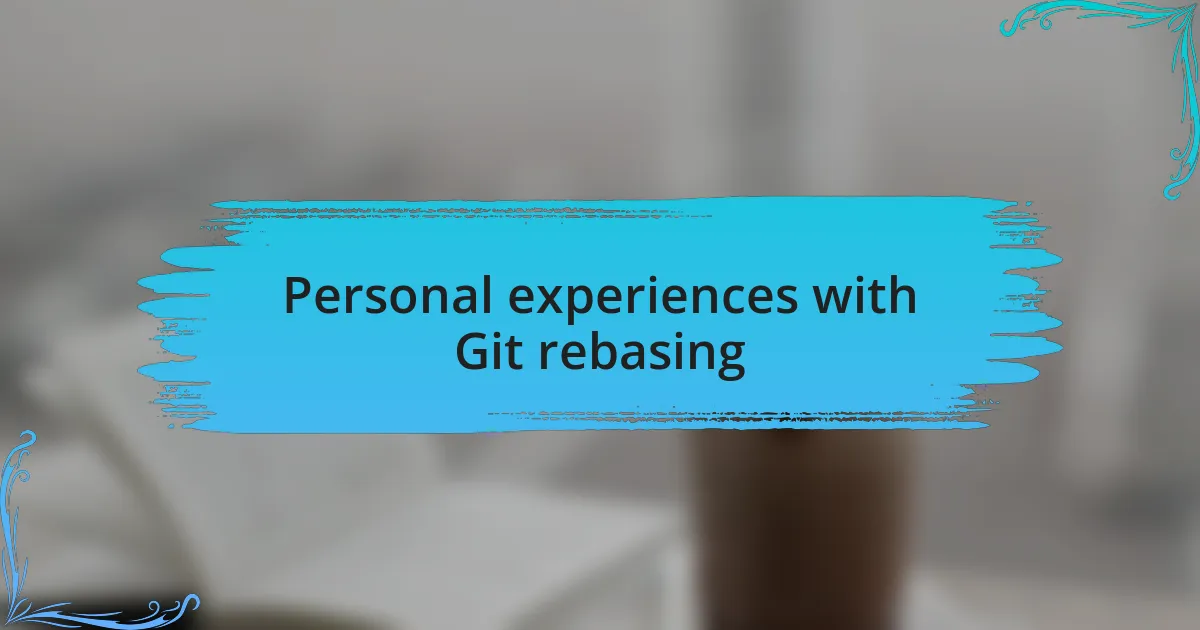
Personal experiences with Git rebasing
There was a time when I understood the fundamentals of Git, yet rebasing seemed daunting. I remember feeling overwhelmed when I first attempted it on a project with a tight deadline. I decided to give it a shot anyway, cautiously rebasing my changes. To my surprise, it went smoothly, and the sense of relief was palpable. It felt like mastering a rite of passage; I was no longer just getting by—I was confidently enhancing my workflow. Have you ever felt that rush of confidence from overcoming a technical challenge?
In another instance, I stumbled across an unexpected issue while rebasing. I had unintentionally created a conflict between my branch and the main branch, sending a wave of anxiety through me. But instead of panicking, I took a deep breath and tackled it methodically, resolving the conflicts line by line. This experience taught me that rebasing is not just about code; it’s also about developing patience and problem-solving skills. Have you found that certain challenges in coding have forced you to grow personally, as well as professionally?
One memorable experience involved collaborating on a project with remote teammates. We relied heavily on rebasing to synchronize our efforts from different time zones. Each time I pushed my rebased branch, I felt a strong sense of teamwork, even from miles apart. The clarity of our commit history became a point of pride, as it reflected not just the effort but the unity we built. Have you ever participated in a project that highlighted the power of collaboration in a way that still resonates with you?
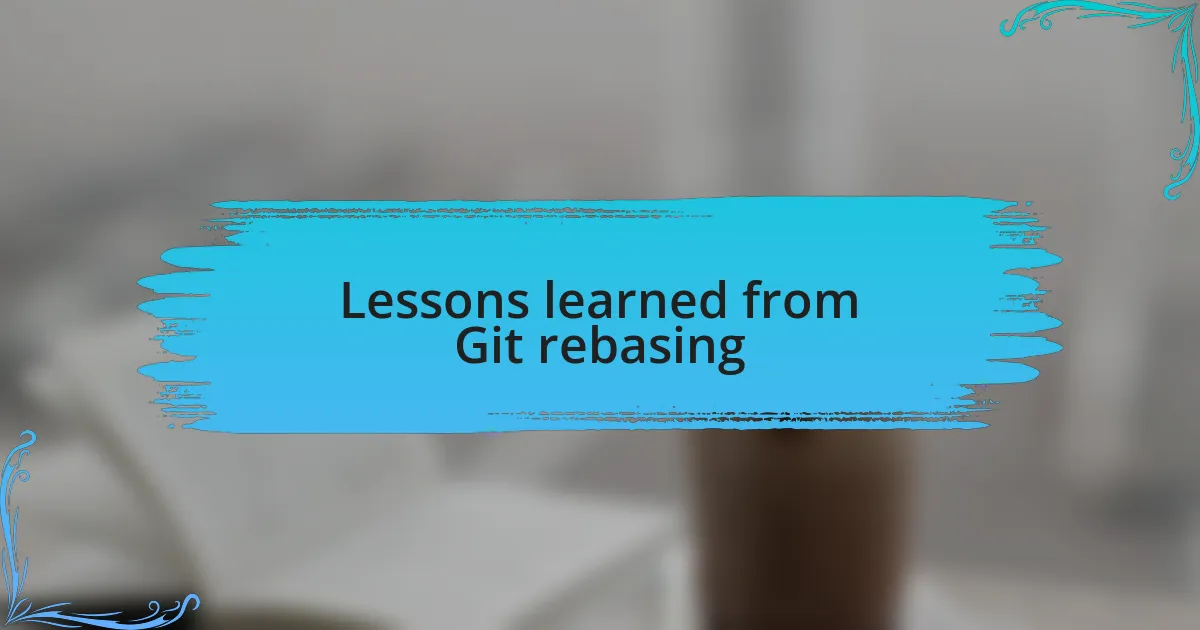
Lessons learned from Git rebasing
When I first embraced Git rebasing, it taught me the importance of keeping a clean commit history. I vividly recall working on a feature branch cluttered with messy commits and realizing how challenging it was to understand the project’s evolution. After I rebased and squashed my commits, everything felt clearer, like lifting a fog. Have you ever experienced the satisfaction of transforming chaos into clarity?
Through my journey with rebasing, I learned that communication among team members is crucial. There was a project where I didn’t inform my teammates before rebasing, and I quickly faced struggles with sync issues. This moment of miscommunication served as a reminder of the balance between individual work and collaborative efforts. It made me wonder, how often do we forget to communicate shifts in our workflow that can impact the whole team?
Finally, I found rebasing to be a great exercise in humility and adaptability. There was a time when my first attempt ended in a confusing mess, and I had to rewind my changes. Instead of feeling defeated, I reflected on what went wrong and adjusted my approach for next time. This humility is valuable; after all, coding is as much about learning from mistakes as it is about implementing solutions. Have you had moments where setbacks became your greatest teachers?
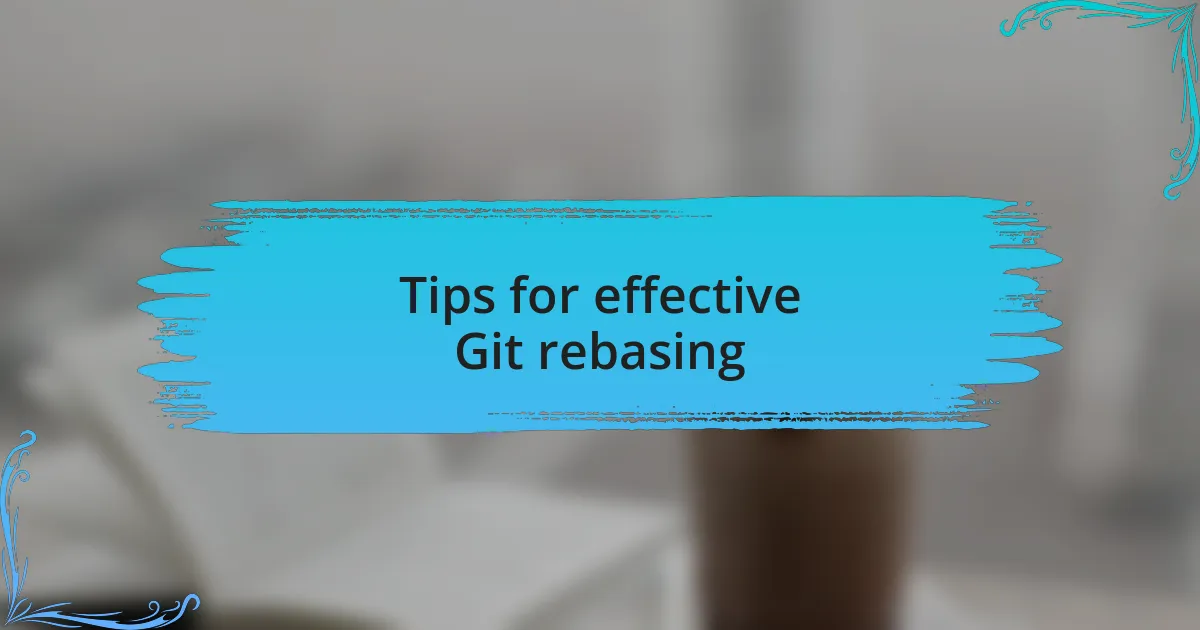
Tips for effective Git rebasing
When you’re gearing up for a rebase, always take a moment to review your commit history. I remember one time being so eager to get my changes in that I skipped this step, and it ended up costing me valuable time to resolve conflicts later. Have you ever wished you could just rewind time? A thorough examination helps you identify any problematic commits that might introduce headaches down the road.
Another effective tip is to practice rebasing frequently in smaller, manageable chunks. I’ll never forget the relief I felt when I decided to rebase my changes after every few feature additions instead of waiting until the end of a long sprint. It was like going through a messy attic and organizing it piece by piece; the process was way less overwhelming and far more satisfying. Have you ever tackled a big project and felt that weight lift off your shoulders when you took it step by step?
Lastly, always remember to perform a dry run using git rebase --interactive or git rebase --onto to visualize the changes before you commit to them. I found this step invaluable after messing up a branch once; it gave me the chance to see potential conflicts and decide which commits to retain or squash. Could this small act of foresight change the way you handle collaborations, too? Embracing patience in this process is truly key to a smooth rebase experience.